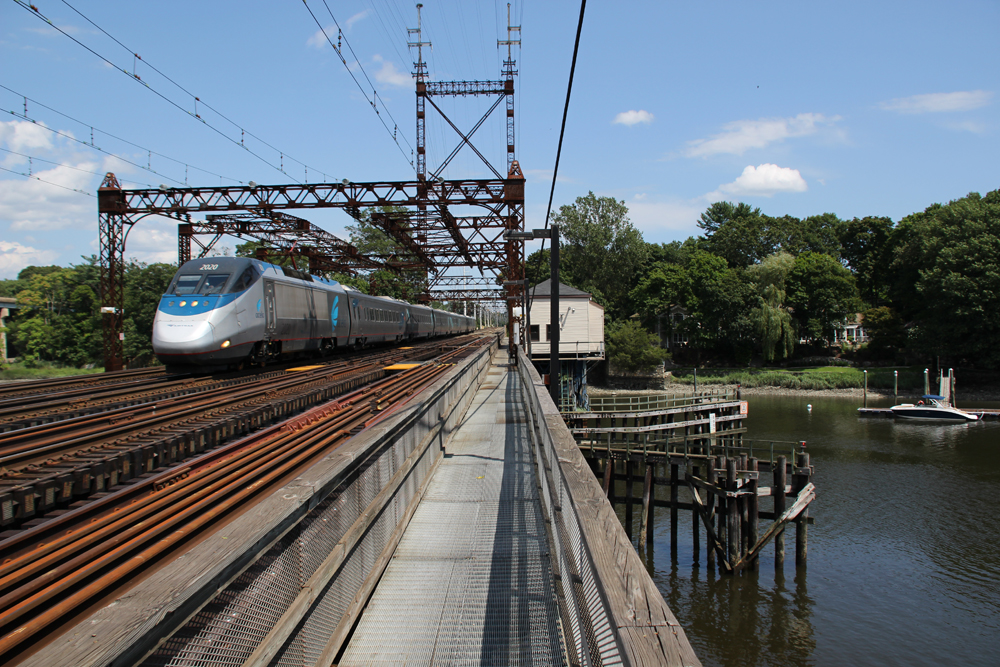
WASHINGTON — The U.S. Department of Transportation is offering nearly $9 billion in grants to upgrade the Northeast Corridor through a Federal Railroad Administration program, the FRA announced on Thursday.
FRA Administrator Amit Bose said in a press release that the funding is “a major step towards reversing a half-century of underinvestment in vital rail infrastructure and will result in fewer delays for millions of riders and travelers.The expanded Partnership Program funded by the Bipartisan Infrastructure Law will ensure that the Northeast Corridor thrives as the region’s economic and transportation backbone, while making its services more reliable, available, and accessible to even more people.”
The Notice of Funding Opportunity to be published in the Federal Register on Tuesday, Dec. 27, will offer the funds through the Federal-State Partnership for Intercity Passenger Rail Grant Program. It will fund infrastructure, equipment, and facilities, including bridge, tunnel, station, and track work. Applications for the funds will be due 90 days after publication.
Awards under the program will be guided by the NEC Project Inventory. That document, issued by the FRA in November, lists more than 68 corridor projects with a total cost of more than $105 billion that need to be addressed. The list includes 15 projects with a total cost of more than $40 billion labeled as “Major Backlog Projects,” only one of which, New Jersey’s Portal North Bridge, is fully funded.
Among those projects: replacement of Baltimore’s 149-year-old B&P tunnel, estimated to cost $6.03 billion, and 10 bridge replacement projects, seven of which are estimated to cost $1 billion or more.
Mitch Warren, executive director of the Northeast Corridor Commission, which guides efforts to improve the route, told the Washington Post that the funding represents “the first significant investment for the infrastructure in generations” and “a historic investment for the corridor.”













As a first year business student in 1976 I saw a GIANT CLUSTER coming when Amtrak took over the Northeast Corridor. The vast majority of trains run on the corridor are NOT AMTRAK. Most are from the various commuter agencies. While they did pay user fees for trackage rights, they NEVER came close to offsetting the true cost of maintenance and upkeep of the lines much less put money in a rainy day fund for future long term projects.
Those Agencies and States need to cough up some big bucks to help. Give me a good reason why Joe the plumber from Colorado or Jane the Nurse from Ohio need to contribute their tax dollars to this project.
And the lawyers, consultants, and union bosses are all salivating at the thoughts of how they can dip their hands into that honey-pot of money!
Meanwhile, I wonder if FRA administrator Bose knows that Amtrak #8 arrived CHI on the 20 some 17 hours late and part of that delay was account all three brand new ALC42s crapped out somewhere in NDak. And if there had not been one P42 in the engine consist to provide HEP there might have been a disaster like what befell the passengers on #351 of 11/7. Or if Mr. Bose knows, does he even care? It’s all well and good to finally start serious work on getting the weak points of the NEC fixed. But why is Mr. Bose and SecTrans Buttigieg not out there demanding explanations for what happened to #8-18? Why at the same time as he is lavishing attention to the NEC aren’t these two seeking accountability at Amtrak and Siemens?
I’m curious about the four locos. It’s nothing new for extra traction or extra hotel power (steam heat long ago, or HEP electricity now) on the Great Northern route in winter. But four locomotives? Were to some these positioning moves for new Siemens from the Sacramento factory? If so it’s not good when locos fresh off the factory floor crap out.
Was the P42 coincidence? Or did Amtrak want to hedge its bets with reliable HEP, not wanting to evacuate dead passengers?
Catenary work between New Brunswick and Trenton complete. Redesigned fixed tension New Brunswick to Monmouth Junction, constant from there to Trenton. Evaluating for comparative performance results.
Just fund the damn Gateway Program already!
Mr. Thomas,
Unreal huh! Most NY/DC catenary 1930’s vintage. New Acela on 90+ year old infrastructure. Look at how quickly MNRR replaced to New Rochelle.New Haven catenary with constant tension. Amtrak priorities boggle the mind.
Wonder what the status is of a previous project to modernize the NEC catenary between Trenton and New Brunswick. Part has certainly been done, but I am not sure how far north the new catenary actually extends, how much it has cost to date, and whether the installation so far has been assessed as successful. Lots of old wire still to be rebuilt.
The ex-PRR catenary on the NEC is of a standard design and works reliably. MNR catenary was ex-NH and was a mixed bag of unique construction that as far as I know has never been used elsewhere.
The original NEC reconstruction decades ago was to include new catenary but Amtrak found the catenary already in place worked as well as new construction.
I should add the catenary from New Rochelle to New Haven was and is owned by NY State and Connecticut and was not Amtrak’s to rebuild.
One could make a case that the failure of the public’s (mainly congress) to fund the rebuilding of the infrastructure is the major signal failure in economic policy of the sometime -but not today-United States.
$9 Billion toward $105 Billion in infrastructure needs. Nice press release but a whole lot more will be needed.